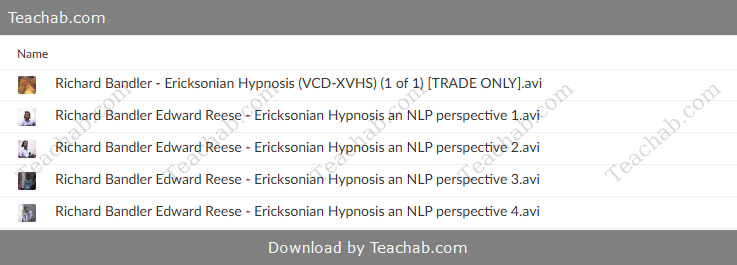Ericksonian Hypnosis – An NLP Perspective by Richard Bandler
$99.00 Original price was: $99.00.$15.40Current price is: $15.40.
Reviewing Ericksonian Hypnosis: An NLP Perspective by Richard Bandler – Immediate Download!
Let See The Content Inside This Course:

Description:
Developed by famed psychiatrist Milton H. Erickson, Ericksonian hypnosis is a transformative therapeutic approach that uses special tactics including metaphor, storytelling, and indirect suggestion. Ericksonian hypnosis is more subtle and flexible than standard hypnotherapy, which frequently depends on explicit instructions and commands. This method places a strong emphasis on comprehending the context of each individual, enabling effective and individualized therapy. John Grinder and Richard Bandler examined Erickson’s tactics to see why they frequently worked better than traditional ways. Their research served as the foundation for the novel framework known as Neuro-Linguistic Programming (NLP), which incorporates numerous Ericksonian hypnotherapy concepts. From an NLP perspective, this paper explores the complexities of Ericksonian hypnosis, highlighting its importance and usefulness in modern therapeutic contexts.

The Foundations of Ericksonian Hypnosis
At the core of Ericksonian hypnosis is the belief that each individual possesses unique experiences and histories that shape their psychological landscape. This perspective empowers therapists to adapt their strategies to better fit the needs and backgrounds of their clients. While traditional hypnotherapy might adopt a ‘one-size-fits-all’ approach, Ericksonian hypnosis encourages flexibility and creativity. Bandler has highlighted this adaptability as a defining characteristic of Erickson’s success as a therapist, enabling profound therapeutic outcomes without igniting client resistance.
Key Techniques Utilized
- Utilization: This technique involves employing the client’s day-to-day experiences and behaviors during therapy sessions. By integrating familiar elements into therapeutic conversations, therapists can facilitate change while minimizing resistance.
- Language Patterns: The hallmark of Ericksonian hypnosis lies in its sophisticated use of language. Through the Milton Model, Bandler has formalized Erickson’s indirect suggestions into structured language patterns that engage the subconscious mind. By using metaphors and ambiguous phrases, therapists can introduce ideas that bypass the client’s conscious resistance.
- Confusion Techniques: One of the more fascinating aspects of Ericksonian hypnosis is the confusion technique. By presenting complex sentences that challenge the client’s cognitive processing, therapists temporarily disable the logical mind. This creates an opening for transformative ideas to enter the subconscious, facilitating significant changes in perception and behavior.
Overall, these techniques showcase the innovative spirit of Ericksonian hypnosis. By prioritizing adaptability and effective language use, both Bandler and Erickson have carved out a distinctive niche in therapeutic practices that focus on deep psychological change.
The NLP Perspective on Ericksonian Hypnosis
From an NLP perspective, Ericksonian hypnosis presents a groundbreaking approach to therapy that respects the autonomy of clients while tapping into the untapped potential of the unconscious mind. The structured methodologies cultivated by Bandler and Grinder, embedded in NLP, echo many principles of Erickson’s approach.
Honoring the Autonomy of the Client
In line with Ericksonian hypnosis, one of the core principles of NLP is the significance of honoring the client’s autonomy throughout sessions. This entails assisting clients in discovering their own insights rather than forcing answers or instructions. This method’s respectful compassion creates an atmosphere that is favorable to recovery and self-discovery.
The Unconscious Mind’s Potential
Another similarity between NLP and Ericksonian hypnosis is the understanding of the power of the unconscious mind. Practitioners can use this perspective to encourage growth and transformation by realizing that a large portion of our thoughts, behaviors, and emotions are the result of subconscious processes.
Therapists can help their clients make big changes in their views and enhance their mental health by using strategies that use metaphor and storytelling to activate the subconscious.
Table: Key Principles of Ericksonian Hypnosis vs. Traditional Hypnotherapy
| Principle | Ericksonian Hypnosis | Traditional Hypnotherapy |
| Approach | Indirect suggestions, metaphorical storytelling | Direct commands, authoritative suggestions |
| Flexibility | Tailored to individual experiences and needs | Generally uniform, less adaptable |
| Resistance Handling | Uses familiar concepts to reduce resistance | Commands may provoke resistance |
| Language Use | Engages the subconscious through complex language | Simpler, more direct language |
| Therapist-Client Dynamic | Collaborative, emphasizing client autonomy | Hierarchical, therapist dictates the process |
The Lasting Impact of Ericksonian Hypnosis
The influence of Ericksonian hypnosis is profound and far-reaching. It has not only reshaped the landscape of hypnotherapy but has also permeated various fields, including coaching, psychotherapy, and personal development. The emphasis on flexibility, client-centric approaches, and the creative use of language has inspired countless practitioners to adopt similar methods in their work.
Extending Uses
Nowadays, Ericksonian concepts are widely included into the treatments of contemporary hypnotists. This departure from conventional approaches demonstrates how therapeutic paradigms are changing to become more person-centered. As a result, practitioners who possess NLP techniques are in a good position to handle a variety of psychological problems, ranging from performance improvement to anxiety and despair.
An Attestation to the Legacy of Milton Erickson
Modern approaches to psychotherapy are still influenced and guided by Milton Erickson’s pioneering ideas and techniques. His distinct approach leveraged the potency of metaphor, storytelling, and indirect communication, enabling him to establish a strong connection with his clients and promote genuine change. In addition to ensuring these ideas’ validity in our current understanding of the human mind, Bandler’s work in formalizing them has strengthened their usefulness in clinical settings.
In conclusion
In conclusion, Ericksonian hypnosis provides a therapeutic approach that is transformative and very different from traditional techniques. According to Richard Bandler’s interpretation of NLP, this therapeutic approach respects the autonomy of the client, emphasizes personal adaptation, and makes use of the unconscious mind’s potential. The ideas developed by Erickson and Bandler continue to be fundamental to successful and caring psychological practice as the discipline of hypnotherapy develops, demonstrating the long-lasting influence of their contributions. The combination of these concepts emphasizes the value of flexibility, originality, and a deep regard for the client, guaranteeing that Ericksonian hypnosis will continue to be essential to attaining therapeutic success in a variety of settings.
Frequently Requested Enquiries:
Innovation in Business Models: We employ a group buying strategy that allows customers to divide costs and receive a lower rate for popular courses. Despite content providers’ concerns about distribution tactics, this approach benefits low-income individuals.
Legal Aspects: The legality of our conduct raises a number of complex issues. Although we do not have the course developer’s official permission to redistribute their content, there are no clear resale restrictions stated at the time of purchase. We have the opportunity to provide affordable educational resources because of this uncertainty.
Quality Control: We ensure that all of the course materials we purchase are identical to those supplied by the writers. However, it is important to understand that we are not approved vendors. Consequently, our products don’t include:
– In-person consultations or phone conversations with the course developer for advice.
– Access to sites or organizations that are exclusive to authors.
– Engaging in private forums.
– Simple email support from the author or their team.
By offering these courses independently, without the premium services of the official channels, we hope to reduce the barrier to education. We appreciate your understanding of our unique approach.
Be the first to review “Ericksonian Hypnosis – An NLP Perspective by Richard Bandler” Cancel reply
You must be logged in to post a review.

















Reviews
There are no reviews yet.